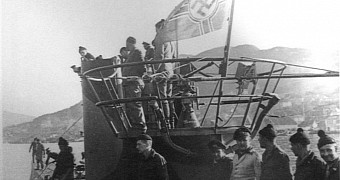Just yesterday, the US National Oceanic and Atmospheric Administration announced the discovery of two vessels lost decades ago, during World War II, in the waters off the coast of North Carolina.
The vessels, discovered by a team of underwater archaeologists working with the Administration's Office of National Marine Sanctuaries, are said to be the freighter Bluefields and the German U-boat 576.
The remains of the two World War II ships are located at a distance of just 30 miles (48 kilometers) from the shoreline. They might have been enemy vessels during the War, but the freighter and the German U-boat now rest very close to one another on the seafloor.
More precisely, the underwater archaeologists who found these two vessels and documented their exact location say that they sit at a distance of merely 240 yards (some 220 meters) from one another.
How did the ships end up at the bottom of the ocean?
Historians with the National Oceanic and Atmospheric Administration say that the two vessels were lost over 7 decades ago. Thus, records indicate that they sunk during a battle that took place on July 15, 1942, Science Daily informs.
On that day, as many as 19 merchant ships left Norfolk, Virginia, and headed for Key West, Florida. The ships carried war cargo and were escorted by the Navy and the Coast Guard vessels and aircraft.
Having reached Cape Hatteras, the convoy came face to face with the German U-boat 576, whose crew attacked the freighter Bluefields together with two other vessels. In retaliation, the US Navy Kingfisher aircraft bombed the German ship.
A merchant ship dubbed Unicoi also got involved in the battle and fired its deck gun at the German U-boat 576. In the aftermath of this confrontation, both the freighter Bluefields and the German ship ended up at the bottom of the ocean.
It is understood that, while the people aboard the freighter were all saved, the German U-boat's crew were all lost when the ship sank. Hence, researchers argue that the site of the German wreck can be described as a war grave.
What's going to happen to the vessels?
As detailed by the National Oceanic and Atmospheric Administration, neither the US nor Germany has any intention to try to recover these ships from the bottom of the ocean. On the contrary, the vessels are to remain where they sank back in 1942.
Still, underwater archaeologists say that they plan to further study them in an attempt to gain a better understanding of what exactly happened on the day that these World War II vessels were lost.
“We have discovered an important battle site that is part of the Battle of the Atlantic. These two ships rest only a few hundred yards apart and together help us interpret and share their forgotten stories,” research Joe Hoyt said in a statement.
“It is international custom to view the wreckage of land, sea, and air vehicles assumed or presumed to hold the remains of fallen soldiers as war graves. As such, they are under special protection and should, if possible, remain at their site and location to allow the dead to rest in peace,” added the German Foreign Office.

 14 DAY TRIAL //
14 DAY TRIAL //